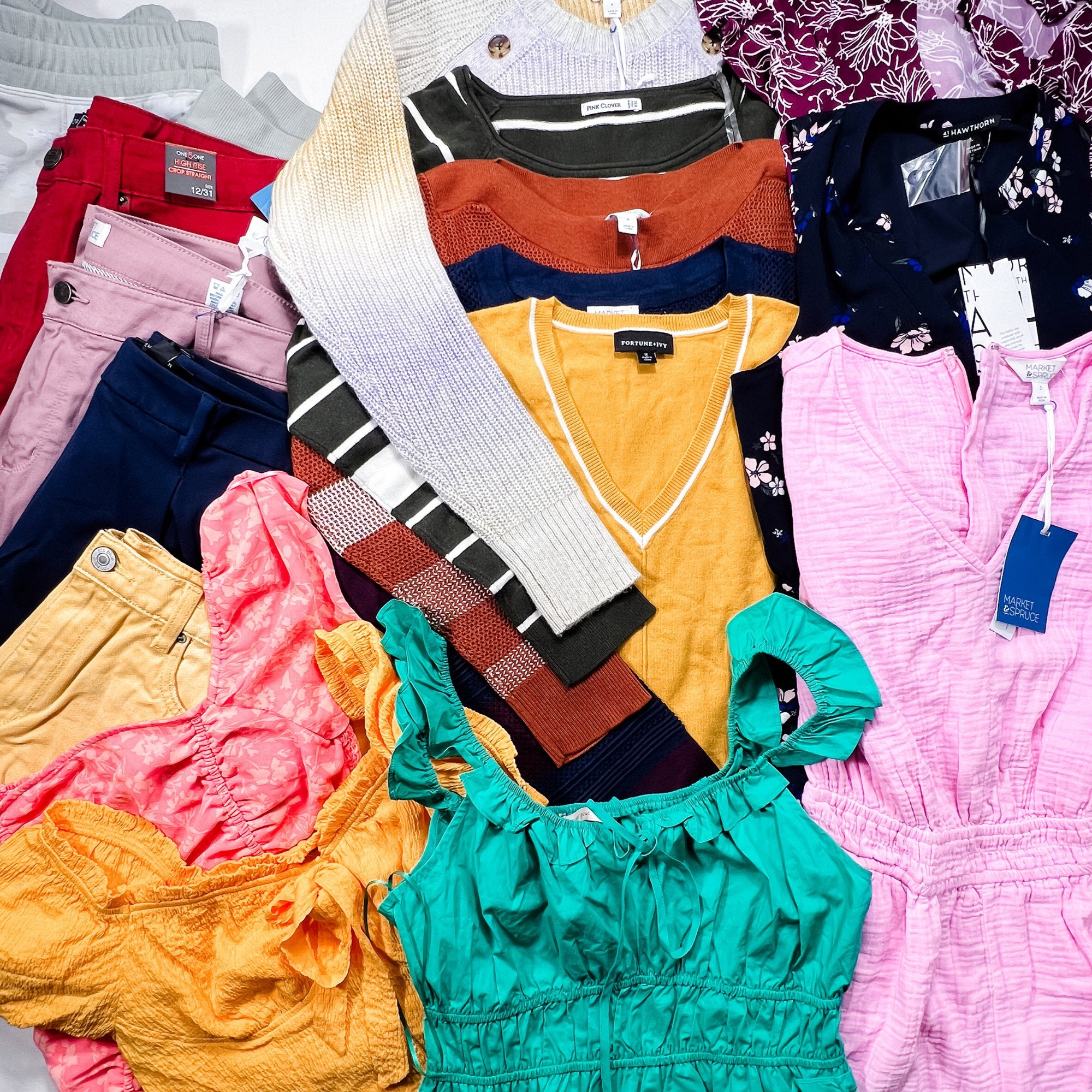The Science Behind Breathability in Branded Clothing Materials
The Science Behind Breathability in Branded Clothing Materials
Blog Article
The Importance of Sustainable Clothing: Just How It Influences the Environment and Your Closet
Sustainable garments is increasingly recognized for its crucial function in lessening the environmental impact of the quick style industry. By concentrating on environment-friendly materials and ethical production techniques, it resolves pressing ecological issues. This shift not only benefits the world but likewise influences customer choices, causing a more thoughtful approach to wardrobe management. Comprehending these dynamics elevates essential inquiries about style's future and individual duty in shaping it.
The Ecological Impact of Quick Fashion

Advantages of Lasting Products
Lasting materials use substantial advantages, particularly via environmentally friendly fabric selections that reduce environmental harm. These materials additionally demonstrate sturdiness and long life, decreasing the demand for constant substitutes. As a result, they contribute to a much more lasting apparel industry and promote responsible customer habits.
Eco-Friendly Fabric Selections
While the garment industry has actually long been related to quick trends and ecological harm, the increase of green fabric selections presents a transformative opportunity. Lasting materials such as organic cotton, hemp, and Tencel have actually acquired popularity due to their lower eco-friendly influence. These materials are commonly produced without unsafe chemicals and need much less water, decreasing their carbon impact - Branded Clothing. Furthermore, many eco-friendly materials are biodegradable, adding to a circular economic situation by lessening waste. Choosing lasting products not just sustains ecologically responsible practices but likewise advertises healthier communities. As consumers end up being much more knowledgeable about their purchasing power, the need for environment-friendly fabrics urges brands to introduce and take on more sustainable production approaches, ultimately profiting the earth and future generations
Toughness and Longevity Benefits
Many customers are significantly recognizing the durability and durability benefits of sustainable materials in their clothes options. Unlike conventional fabrics, sustainable materials such as natural cotton, hemp, and recycled polyester are engineered to stand up to damage, leading to garments that last much longer. This lowered regularity of substitute not only saves customers money over time but additionally lessens waste created by fast fashion. On top of that, sustainable clothes frequently employs environmentally friendly production methods that enhance fabric stamina, adding to a decrease in the overall carbon footprint. By purchasing resilient clothing, customers can cultivate a more lasting wardrobe while enjoying top quality items that preserve their visual and performance gradually. Consequently, sturdiness and durability stand as vital advantages of picking sustainable products.
Minimizing Waste Through Lasting Practices
Reducing waste in the fashion business can be achieved through ingenious methods such as upcycling and repurposing materials. Furthermore, taking on minimalist closet strategies motivates consumers to focus on quality over amount, ultimately decreasing garments consumption. Together, these strategies add substantially to a more lasting clothing design.
Upcycling and Repurposing Products
Upcycling and repurposing products have actually become ingenious strategies in the fashion business, transforming disposed of fabrics into useful new products. This strategy not only reduces waste however additionally encourages creativity and individuality in apparel design. By taking old garments and products, designers can produce special pieces that reflect personal style while lowering the demand for new sources. In addition, upcycling often needs much less power and water compared to standard manufacturing processes, substantially lowering the environmental footprint of fashion. As consumers become more knowledgeable about sustainability, the popularity of upcycled clothes remains to rise, promoting a circular economy. Ultimately, these practices contribute to a more lasting future, where style prioritizes ecological health and wellness over quick production and consumption.

Minimalist Closet Approaches
As people significantly look for to lessen their ecological impact, adopting minimal wardrobe strategies has acquired traction as an efficient method to lasting fashion. These strategies highlight quality over quantity, encouraging consumers to curate a smaller collection of versatile, long lasting clothing. By concentrating on ageless pieces that can be mixed and matched, individuals can reduce the regularity of purchases and ultimately lower waste.Additionally, minimalism advertises conscious consumption, urging consumers to review the ecological and honest implications of their choices. This approach not only promotes a more lasting lifestyle however likewise simplifies daily decision-making relating to attire. As people embrace minimal concepts, they contribute to a fashion society that values sustainability and liable consumerism, eventually resulting in an extra eco-conscious culture.
The Role of Ethical Labor in Lasting Style
While several customers are increasingly conscious of the ecological effects of their garments options, the relevance of honest labor techniques in sustainable style can not be forgotten. Moral labor incorporates fair incomes, safe working problems, and respect for employees' rights, forming Your Domain Name the foundation of accountable style manufacturing. Brand names that focus on ethical labor not just boost neighborhoods but also established a criterion for responsibility in the industry.Moreover, the combination of ethical methods cultivates transparency, making it possible for consumers to make educated choices about their purchases. This practice contrasts sharply with rapid style's exploitative labor designs, which commonly focus on profit over individuals. By sustaining business devoted to moral labor, consumers add to a system that values human dignity alongside environmental sustainability. Consequently, ethical labor is not merely an add-on; it is essential to the more comprehensive mission of lasting style, making sure that the pursuit for eco-friendliness does not come with the cost of human legal rights.
The Influence of Lasting Clothing on Carbon Emissions
Lasting apparel has the potential to greatly decrease carbon exhausts related to the fashion business. Traditional garment manufacturing contributes especially to greenhouse gas exhausts, largely due to energy-intensive production processes and using non-renewable resources. On the other hand, sustainable style concentrates on green materials, such as organic cotton or recycled fibers, which often need much less energy to produce.Moreover, sustainable brands tend to adopt extra reliable manufacturing practices, reducing waste and reducing overall discharges. By focusing on resilience and timeless design, lasting clothes encourages consumers to buy less often, more reducing the carbon footprint connected with overconsumption.Additionally, several lasting brands are committed to openness in their supply chains, making it possible for consumers to make educated options that straighten with their values. Eventually, moving in the direction of lasting garments can cause a significant reduction in carbon exhausts, contributing to a much healthier earth and a more sustainable future for the fashion business.
Sustaining Regional Economic Climates With Sustainable Options
The shift toward lasting garments not just addresses ecological problems but likewise substantially advantages local economies. By picking lasting style, customers typically sustain small organizations and local craftsmens, enhancing area durability. These business usually operate a smaller sized scale, focusing on workmanship and moral practices over mass production.Investing in locally made lasting clothes cultivates task creation and boosts financial growth within neighborhoods. As consumers come to be more familiar with the environmental impact of their acquisitions, they increasingly look for products that mirror their worths. This demand motivates neighborhood producers to embrace sustainable methods, adding to a circular economy.Moreover, sustaining neighborhood businesses reduces transportation exhausts, straightening with eco-conscious consumer actions. The interconnectedness of sustainable clothing and neighborhood economic situations underscores the necessary role that specific choices play in promoting both ecological and financial health and wellness. By cultivating these regional links, neighborhoods can thrive while also functioning in the direction of an extra sustainable future.
Transforming Your Storage Room: Tips for a Sustainable Wardrobe
As people seek to lower their environmental influence, changing a storage room right into a sustainable closet becomes an essential step. special info One reliable approach is to assess existing apparel, maintaining only things that are used on a regular basis and that line up with sustainability goals. Prioritizing quality over quantity is important; buying durable pieces from eco-friendly brand names can greatly decrease waste.Additionally, incorporating second-hand things can revive a closet while decreasing ecological damages. Organizing garments swaps with friends or contributing extra items can better advertise sustainability.When shopping, people ought to seek products that are natural, recycled, or eco-friendly, and prevent quick style retailers - Branded Clothing. Practicing mindful intake by attentively taking into consideration each acquisition can add to a more lasting way of life. By applying these pointers, one can develop a wardrobe that shows individual style while supporting environmental stewardship
Frequently Asked Questions
How Can I Identify Sustainable Clothing Brands?
To identify sustainable garments brands, one need to investigate materials used, examine her comment is here for qualifications like Fair Trade, and take a look at the brand name's openness regarding their manufacturing procedures, labor techniques, and ecological effect, making certain green and ethical practices are prioritized.
What Are the Expenses Connected With Sustainable Fashion?
The prices related to lasting style can vary significantly. Greater manufacturing expenses, honest sourcing, and environment-friendly materials typically bring about boosted market prices, which may hinder some consumers while interesting ecologically conscious consumers.
Can Sustainable Clothes Be Trendy and Trendy?
Lasting garments can without a doubt be stylish and fashionable. Developers significantly focus on ingenious materials and moral production techniques, proving that fashion and sustainability can exist side-by-side. Consumers now have diverse choices that mix appearances with environmental awareness.
Exactly How Does Washing Garments Affect Their Sustainability?
Cleaning clothes greatly influences sustainability by consuming water and energy, adding to contamination, and triggering microplastic launch. Frequent washing can break down textiles, shortening their life-span and boosting the requirement for substitutes, eventually exacerbating environmental concerns.
What Is the Life Expectancy of Lasting Clothing Compared to Quick Fashion?
The life expectancy of lasting clothes generally exceeds that of fast style things, usually lasting a number of years because of high quality products and workmanship. On the other hand, quick fashion garments might weaken quickly, necessitating even more constant substitutes. Lasting garments is increasingly recognized for its crucial duty in lessening the ecological effect of the fast style market. While many customers are significantly aware of the ecological repercussions of their garments options, the significance of moral labor techniques in sustainable fashion can not be forgotten. Branded Clothing. Sustainable clothing has the potential to significantly decrease carbon exhausts connected with the fashion market. In comparison, sustainable style focuses on environmentally friendly products, such as natural cotton or recycled fibers, which commonly call for less energy to produce.Moreover, lasting brands often tend to take on much more efficient manufacturing practices, reducing waste and decreasing overall emissions. By prioritizing sturdiness and classic style, sustainable clothing motivates customers to acquire less frequently, more reducing the carbon footprint associated with overconsumption.Additionally, several lasting brands are devoted to openness in their supply chains, making it possible for consumers to make enlightened choices that straighten with their values
Report this page